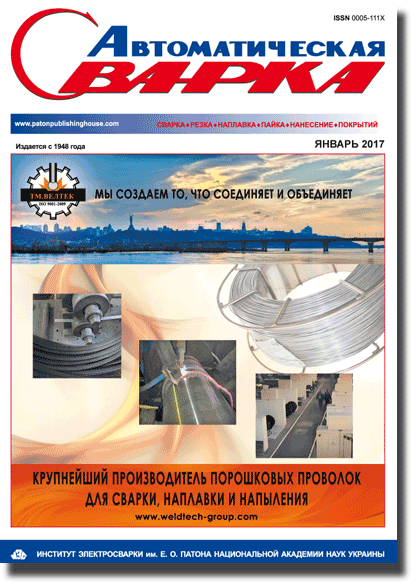| 2017 №01 (10) |
DOI of Article 10.15407/as2017.01.11 |
2017 №01 (12) |

Avtomaticheskaya Svarka (Automatic Welding), #1, 2017, pp. 68-72
Adhesion-active high-temperature wear-resistant surfacing consumables KMKh and KMKhS
A.M. Kostin1, V.A. Martynenko1, A.B. Maly2 and V.V. Kvasnitsky3
1Admiral Makarov National University of Shipbuilding 9 Geroev Stalingrada Ave., 54025, Mykolaiv, Ukraine. E-mail:university@nuos.edu.ua
2SE GTSPC «Zorya-Mashproekt» 42-a Bogoyavlensky Ave., 54018, Mykolaiv, Ukraine. E-mail:office@zorya.com.ua
3NTUU «Igor Sikorsky KPI» 37 Pobedy Ave., 03056, Kiev, Ukraine. E-mail:kvas69@ukr.net
Abstract
Adhesion-active high-temperature wear-resistant composite surfacing consumables KMKh and KMKhS were developed. They provide for significant increase of wear resistance of contact surfaces of parts of hot gas path in gas turbine engines. It is determined that additional introduction of chromium carbide in alloy based on solid solution of cobalt, alloyed by molybdenum, chromium, boron and silicon, promotes for stabilization of its structure and properties with simultaneous decrease of melting temperature of composition. Boron and silicon provide for increase of adhesion alloy activity in deposition on contact surfaces and form uniformly distributed thermodynamically stable high-dispersion complex silicides and borides. Wear resistance tests show that average value of wear intensity of working surfaces, deposited with new KMKh and KMKhS consumables, are 3–4 times lower under conditions of operation in oxidizing medium at critical temperatures, than the surfaces deposited with known commercial alloys. High characteristics of wear resistance and possibility of work under critical temperatures allowed recommending developed composite consumables and technology of their surfacing to commercial application. 10 Ref., 3 Tables, 1 Figure.
Keywords: surfacing, adhesion-active wear-resistant composite consumables, high-temperature alloys, structure, phase composition, wear intensity
Received: 16.02.17
Published: 09.12.16
References
- Kostin, A.M., Butenko, A.Yu., Kvasnitsky, V.V. (2014) Materials for strengthening of gas turbine blades. The Paton Welding J., 6/7, 132–134. https://doi.org/10.15407/tpwj2014.06.28
- Kostin, A.M., Butenko, A.Yu., Maly, A.B. (2012) Analysis of materials for strengthening of turbine blade platforms (Review). Vestnik NUK, 5, 137–141. http://ev.nuos.edu.ua/ru/material?publicationId=19317
- Altukhov, A.A., Gavrilov, O.V. (2004) Application of heat-resistant consumable KBNKhL-2 for surfacing of gas turbine parts. Svarshchik, 2, 22–23.
- Pejchev, G.I., Zamkovoj, V.E., Andrejchenko, N.V. (2009) Comparative characteristics of wear-resistant alloys for strengthening of blades platforms of gas turbine engines. Vestnik Dvigatelestroeniya, 2, 123–125.
- Som, A.I., Ishchenko, V.Yu., Maly, A.B. (2004) Stellite plasma-powder surfacing with of pipe clamps. Svarshchik, 2, 18–19.
- Dmitrieva, G.P., Cherepova, T.S., Kosorukova, T.A. et al. (2015) Structure and properties of wear-resistant alloy based on cobalt with niobium carbide. Metallofizika i Novejshie Tekhnologii, 37(7), 973–986. https://doi.org/10.15407/mfint.37.07.0973
- Kostin, O.M., Martynenko, V.O., Maly, O.B. et al. Wear-resistant high-temperature composite alloy based on cobalt. Pat. 107286 Ukraine. Int. Cl. C22C 19/07, C22F 1/10. Fill. 21.12.2015; Publ. 25.05.2016.
- Kostin, O.M., Martynenko, V.O., Maly, O.B. et al. Wear-resistant high-temperature composite alloy based on cobalt. Pat. 111213 Ukraine. Int. Cl. C22C 19/07, C22C 29/00. Fill. 22.03.2016; Publ. 10.11.2016.
- Mirkin, L.I. (1979) X-ray testing of machine-building materials: Refer. Moscow: Mashinostroenie.
- Ivshchenko, L.J., Andrienko, A.G. (1996) Method of tribological tests under conditions of cyclic force and temperature loading. Metaloznavstvo ta Obrobka Metaliv, 3, 62–65.
The cost of subscription/purchase order journals or individual articles
| Journal/Currency | Annual Set | 1 issue printed |
1 issue |
one article |
| TPWJ/USD | 384 $ | 32 $ | 26 $ | 13 $ |
| TPWJ/EUR | 348 € | 29 € | 24 € | 12 € |
| TPWJ/UAH | 7200 UAH | 600 UAH | 600 UAH | 280 UAH |
| AS/UAH | 1800 UAH | 300 UAH | 300 UAH | 150 UAH |
| AS/USD | 192 $ | 32 $ | 26 $ | 13 $ |
| AS/EUR | 180 € | 30 € | 25 € | 12 € |
| SEM/UAH | 1200 UAH | 300 UAH | 300 UAH | 150 UAH |
| SEM/USD | 128 $ | 32 $ | 26 $ | 13 $ |
| SEM/EUR | 120 € | 30 € | 25 € | 12 € |
| TDNK/UAH | 1200 UAH | 300 UAH | 300 UAH | 150 UAH |
| TDNK/USD | 128 $ | 32 $ | 26 $ | 13 $ |
| TDNK/EUR | 120 € | 30 € | 25 € | 15 € |
AS = «Automatic Welding» - 6 issues per year;
TPWJ = «PATON WELDING JOURNAL» - 12 issues per year;
SEM = «Electrometallurgy Today» - 4 issues per year;
TDNK = «Technical Diagnostics and Non-Destructive Testing» - 4 issues per year.





